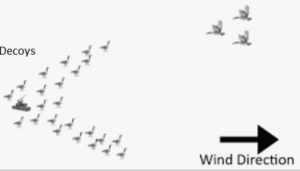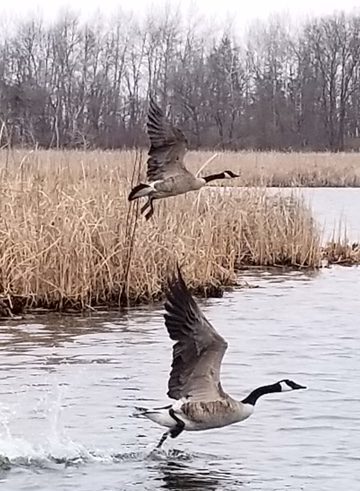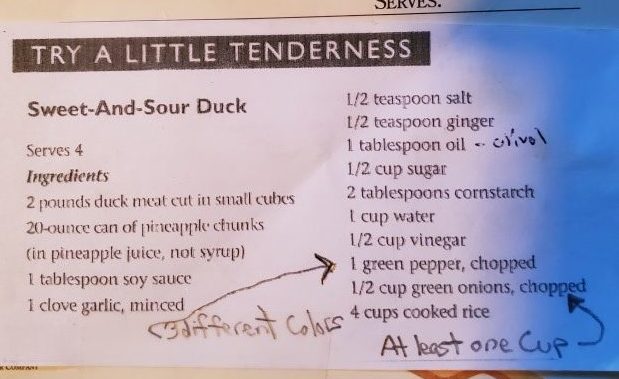An article from WWA’s Words From The Wardens.
This article originally appeared in Wisconsin Waterfowl Association’s November 2019 eNewsletter.
 By WDNR Conservation Warden Michael Hirschboeck
By WDNR Conservation Warden Michael Hirschboeck
When it comes to field hunting considerations for geese, I’ve had success using the tips I’ll offer you in this column. And, make sure you get to the end where I share some recipes that have been a hit with all ages.
Hunting in an urban area can be difficult! You must have permission to hunt a field and cannot be within 300 feet of a dwelling devoted to human occupancy.
Scouting and Permission: Two of the most important parts!
I call scouting and permission two of the most important parts of a successful hunt. Knowing where the birds are roosting, and feeding is crucial – and this takes some time and gas in your vehicle.
Next is approaching the property owner and getting permission to occupy the field. If permission is obtained, treat the property as if were your own. Do not rut up the field. If the field is wet, haul your gear in on foot and take out everything you brought back out with you.
Know who the surrounding neighbors are. I’ve responded to multiple calls for field hunters who were hunting within 300 feet of a dwelling devoted to human occupancy.
Here is the State Statute 941.20(1)(d) Endangering safety by use of dangerous weapon:
- 941.20(1)(d) (d) While on the lands of another discharges a firearm within 100 yards of any building devoted to human occupancy situated on and attached to the lands of another without the express permission of the owner or occupant of the building. “Building” as used in this paragraph does not include any tent, bus, truck, vehicle or similar portable unit.
While contacting the neighbors and informing them you’ll be hunting is courteous, it also gives you the opportunity to tell them you’ll hunt safely and respect their property as well. I’ve contacted neighbors who declined access, and I’ve contacted neighbors who didn’t like geese and gave me permission to hunt their property as well. Just make sure you seek their permission and honor their decision.
Here is another reminder:
- NR 10.07 General hunting.
- NR 10.07(1)(1) Prohibited methods. No person shall:
- NR 10.07(1)(f) (f) Retrieval. Fail to make every reasonable effort to retrieve all wild animals killed or crippled; and until such effort is made, such wild animals shall be included in the daily bag.
- NR 10.07(1)(1) Prohibited methods. No person shall:
Equipment
Layout blinds, A frames, calls, flags, full bodied decoys, shells, silhouettes and more! All are great equipment and gear to have but it can get expensive.
- If you’ll be using layout blinds or an A Frame, they both will have molly loops to attach the vegetation that’s around you to conceal your blind. Also, have a small rake, or by hand blend in the bottom of the frame of your blind with the vegetation around you so it doesn’t look like a box or rectangle from above and out of place.
- One thing that saved me money was making my own silhouettes. Simply purchase the thinnest plywood you can. You can clamp 5 pieces of plywood together, draw out the silhouettes you want, drill a hole at the bottom of each silhouette (for attaching metal tent stakes) and cut out 5 silhouettes at a time. Then all you need to do is have nuts, bolts, and washers to attach the tent stakes, place the silhouettes out and spray paint them.
 Decoys: When placing your decoys, you must take the wind direction into consideration. Waterfowl will always use the wind to help break their fall/landing. They will land into the wind.
Decoys: When placing your decoys, you must take the wind direction into consideration. Waterfowl will always use the wind to help break their fall/landing. They will land into the wind.
- You can set your decoy spread up in a “U” type formation (There are many variations). Keep in mind that there needs to be a landing zone in the middle of your set (field strip). This is where the incoming geese should feel safe and comfortable to land. This will aid in your fields of fire when they are landing so you can control your distances of shooting and making successful and ethical shots.
- If you find that the geese are flaring out as they are approaching, get out there and look at your set. Make adjustments and carry on. Adjustments commonly are needed.
- If you’re calling or flagging birds and they turn in, slow down the calling and flagging and let the birds work. Sometimes the best call is no call.
Other Considerations if you don’t have a blind:
- Whether you have a blind or not, consider using what’s around you. If you have a bordering tree line or a partially cut corn field, consider using the tree line or stand in the standing corn for cover. Set your decoys utilizing the wind and handle the incoming birds as you see fit.
Need help with tasty waterfowl dishes? Try these recipes:




